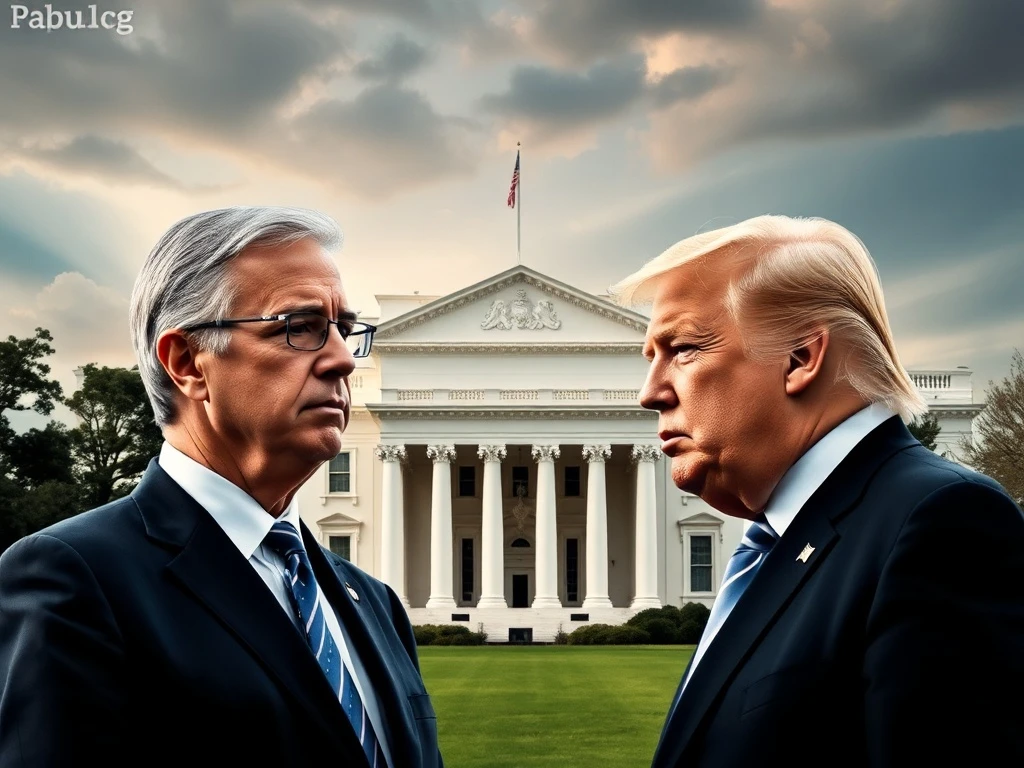Jerome Powell Confronts Donald Trump: Unveiling the Shocking White House Renovation Dispute

In the often-turbulent world where politics meets economics, few spectacles capture attention quite like a direct confrontation between a sitting President and the head of the nation’s central bank. For those navigating the volatile crypto markets, understanding such high-level disputes is crucial, as they can ripple through traditional finance and ultimately influence investor sentiment across all asset classes. This recent, dramatic exchange involving Jerome Powell and Donald Trump is no exception, casting a spotlight on the delicate balance of power and the sanctity of institutional independence. Let’s delve into the details of this astonishing public disagreement.
The White House Renovation Claim: A Clash Over Billions
The core of the recent public spat revolved around a staggering figure: $3.1 billion. During a joint tour of the Federal Reserve’s Washington, D.C. headquarters, former U.S. President Donald Trump asserted that this colossal sum was being spent on a White House renovation project. However, in an unusual and direct challenge to the President’s assertion, Federal Reserve Chair Jerome Powell publicly refuted the claim, stating emphatically, “That’s not true. I haven’t heard that from anybody.”
Powell quickly clarified that the figure cited by Trump erroneously included a separate federal building constructed five years prior, a detail that drastically alters the context of the alleged expenditure. This immediate and public correction from the Fed Chair underscored a fundamental disagreement not just over numbers, but over narrative control and factual accuracy in the highest echelons of government. The actual allocated budget for the White House restoration in 2025 was a significantly lower $360 million, making Trump’s $3.1 billion claim appear vastly inflated.
Understanding Federal Reserve Independence: A Cornerstone of Stability?
At the heart of this confrontation lies the critical concept of Fed independence. The Federal Reserve, often dubbed the ‘lender of last resort’ and the architect of monetary policy, is designed to operate free from political interference. This autonomy is considered vital for making sound economic decisions based on data, rather than short-term political expediency. A politically influenced central bank risks erratic policy shifts, which can destabilize markets and erode public trust.
The Supreme Court’s recent ruling, which reinforced the Fed’s independence, serves as a powerful legal bulwark against attempts to undermine its authority. This ruling makes it legally challenging for a President to remove a Fed Chair without cause, providing a crucial layer of protection for the institution. Historically, periods of strong central bank independence have often correlated with greater economic stability and lower inflation, reinforcing the argument for keeping monetary policy insulated from partisan pressures.
Donald Trump’s Stance: Persistent Pressure on Interest Rates
The Donald Trump administration has a well-documented history of pressuring the Federal Reserve to lower interest rates, often publicly criticizing Chair Powell. This recent exchange during the White House renovation claim further highlights the ongoing tension. Trump, who appointed Powell in 2017, has consistently argued that higher interest rates hinder economic growth, despite the Fed’s mandate to manage inflation and employment.
When asked if Powell could ease his criticisms, Trump’s response was direct: “Well, I’d love him to lower interest rates.” This statement encapsulates the persistent friction between the executive branch’s desire for specific economic outcomes and the Fed’s commitment to its dual mandate. The calls for Powell’s resignation from figures like Billy Pulte, head of the Federal Housing Finance Agency, further amplify these internal administration tensions, even as legal precedents protect the Fed Chair’s position.
Jerome Powell’s Bold Rebuttal: Beyond the Numbers
The significance of Jerome Powell’s public denial extends far beyond correcting a financial figure. It served as a powerful assertion of the Federal Reserve’s institutional independence and its commitment to factual accuracy. In a political climate often characterized by conflicting information, the Fed Chair’s firm stance aligns with his reputation for cautious, evidence-based communication. This contrasts sharply with the more assertive and often improvisational public style of the former President.
Analysts quickly observed that this incident highlighted the delicate balance between political pressure and the Fed’s data-driven approach to monetary policy. For investors, particularly those in the nascent crypto space, such public displays of discord between key economic figures can introduce uncertainty. Undermining confidence in the Fed’s autonomy can lead to broader market instability, affecting everything from bond yields to perceived risk in alternative assets like Bitcoin and Ethereum. The incident sparked renewed debates about federal transparency and the vital role of nonpartisan institutions in verifying executive claims.
Navigating the Waters: Challenges to Fed Independence and Future Outlook
The challenges to Fed independence are not new, but the directness of this public confrontation brings them into sharper focus. Treasury Secretary Scott Bessent joined the fray, expressing confusion over the renovation costs and urging an “internal review” of the Fed’s operations. Bessent criticized the central bank for becoming an “unaccountable agency” and a “new kind of central planning,” echoing broader critiques of federal spending and perceived overreach.
The implications of such disputes are significant. A central bank perceived as susceptible to political pressure may struggle to maintain credibility, both domestically and internationally. This can impact its ability to effectively manage the economy, respond to crises, and maintain stable financial markets. With the 2025 midterms approaching, this exchange could intensify partisan narratives on fiscal responsibility, making the Fed’s role even more scrutinized. The White House has yet to formally respond to the Fed’s rebuttal, leaving the dispute to simmer in the public sphere and signaling continued vigilance is needed from market participants.
The public clash between Jerome Powell and Donald Trump over the White House renovation claim was more than just a disagreement about numbers; it was a potent symbol of the ongoing tension between political ambition and institutional autonomy. Powell’s firm denial underscored the Federal Reserve’s commitment to independence, a principle crucial for market stability and sound economic policy. As political pressures continue to test the boundaries of nonpartisan institutions, the episode serves as a powerful reminder of the delicate balance required to maintain confidence in the nation’s financial leadership. For anyone invested in the global economy, including the dynamic world of cryptocurrencies, monitoring these foundational conflicts remains paramount.
Frequently Asked Questions (FAQs)
Q1: What was the main point of contention between Jerome Powell and Donald Trump?
The primary dispute was over a $3.1 billion claim made by Donald Trump regarding a White House renovation project. Jerome Powell publicly denied this figure, clarifying that it incorrectly included the cost of a separate federal building constructed years earlier.
Q2: Why is the Federal Reserve’s independence important?
The Federal Reserve’s independence is crucial because it allows the central bank to make monetary policy decisions based on economic data and long-term stability goals, rather than short-term political pressures. This autonomy helps maintain market confidence, control inflation, and support sustainable economic growth.
Q3: How does this dispute relate to Donald Trump’s past criticisms of Jerome Powell?
This incident is part of a broader pattern of criticism from Donald Trump towards Jerome Powell, particularly concerning interest rates. Trump has consistently called for lower interest rates, often publicly expressing his dissatisfaction with the Fed’s monetary policy decisions.
Q4: What was the actual budget allocated for the White House renovation?
The actual allocated budget for the White House restoration in the 2025 budget was significantly lower than Trump’s claim, totaling $360 million, not $3.1 billion.
Q5: What are the potential implications of such public disagreements for markets?
Public disagreements between high-ranking political figures and the Federal Reserve can create uncertainty in financial markets. They can undermine investor confidence in the stability and independence of economic institutions, potentially leading to volatility in various asset classes, including traditional stocks, bonds, and cryptocurrencies.
Q6: Has the White House formally responded to Powell’s rebuttal?
According to the article, the White House has yet to formally respond to the Fed’s rebuttal, indicating that the dispute remains an open point of contention in the public sphere.






